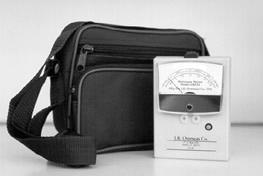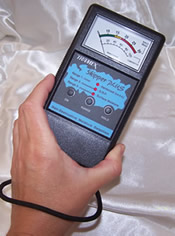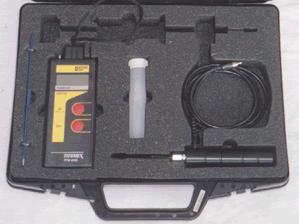 I’ve noticed that whenever a group of marine surveyors spend time comparing notes and discussing their profession, the conversation often turns to moisture meters. Reactions and comments range from “they would make a good doorstop if they were heavier” to “it’s absolutely essential on a Fiberglass boat in order to do a good survey.” That’s quite a range of opinion considering the tool has been used for years in other industries but has only recently become prominent in the checking of fiberglass boat hulls.
I’ve noticed that whenever a group of marine surveyors spend time comparing notes and discussing their profession, the conversation often turns to moisture meters. Reactions and comments range from “they would make a good doorstop if they were heavier” to “it’s absolutely essential on a Fiberglass boat in order to do a good survey.” That’s quite a range of opinion considering the tool has been used for years in other industries but has only recently become prominent in the checking of fiberglass boat hulls.
Fiberglass has many good attributes but it isn’t a perfect. As with all other types of materials, there are drawbacks, some of which are less obvious than others. I will present these drawbacks in a practical (and somewhat over-simplified) manner, based in part on science as well as 40+ years of experience. The latter, I’ll admit, involves my personal feelings and a little speculation.
First, a few statements about basic material properties:
a. Strands of fiberglass, either “E” or “S” type, do not themselves absorb any water. None. Put a glass bottle in water as long as you like and it will not dissolve, gain weight, or lose strength as a result of its exposure to water. It is one of the very few materials in the world, either manmade or natural, that is unaffected by water immersion. (It can, however, be eroded by water flow of sufficient pressure and speed.)
b. A properly catalyzed and fully cured resin, be it “ortho” or “iso” polyester, vinylester, or epoxy, will not absorb enough water to make any significant gains in weight or loss in strength. (Note the qualifier, “properly catalyzed and fully cured.”)
c. Nearly all core or strengthening materials have some affinity for water and will be affected by exposure or immersion, often with disastrous results.
d. Chemical bonding-achieving a homogenous mix-can be accomplished with careful control of the lay-up process between various layers of like resin. All other bonds are secondary and are in effect glue bonds. This includes resin whenever prior layers are allowed to cure sufficiently before more resin is applied.
e. Due to their very low molecular weight and size, water molecules will penetrate almost anything. Nearly all substances, including gel-coats and paints, have some porosity that allows water molecules to enter.
 What happens after water has entered? In the case of fiberglass construction, not too much, provided there are no exposed core materials and the resin was fully catalyzed and cured. If any resin components did not get linked to other components by the catalyst to make a long chain closed molecule, then the open ends of the molecule mix with water, making a “salt” (not table grade) that is larger and heavier than it was before. This is now trapped in the laminate, is usually acidic, and will continue growing so long as more water can be drawn in the entry and additional unlinked resin components can be found. It will also start attacking the glue or encapsulation bonds of all the other materials in the laminate, including the laminate layers that were not chemically bonded during the initial construction.
What happens after water has entered? In the case of fiberglass construction, not too much, provided there are no exposed core materials and the resin was fully catalyzed and cured. If any resin components did not get linked to other components by the catalyst to make a long chain closed molecule, then the open ends of the molecule mix with water, making a “salt” (not table grade) that is larger and heavier than it was before. This is now trapped in the laminate, is usually acidic, and will continue growing so long as more water can be drawn in the entry and additional unlinked resin components can be found. It will also start attacking the glue or encapsulation bonds of all the other materials in the laminate, including the laminate layers that were not chemically bonded during the initial construction.
Many undesirable things happen afterward. Minor blistering is the first; delamination between layers may show up, usually found by visual observation or hammer (percussion) sounding; delamination of FRP layers to various strengthening cores may occur with failure of the structure to carry the loads if the FRP overlay was not strong enough by itself; increased moisture levels of the core materials with wood of any type being particularly vulnerable but plastic cores are also susceptible to major damage.
How does a surveyor or boatyard employee determine how much moisture is present and, more important, assess its potential for damage and possible failure of the structure? Visual inspection and sounding, the first steps in the process, have already been mentioned. Next, the moisture meter is useful in verifying that water has been trapped within the laminate. Without regard to the make or type of meter, I will state that none give a reading that can be related to anything other than an arbitrary scale, which meter manufacturers adopt as their standard for moisture level. Cured resins do not actually absorb enough water to be measured as a percentage of either weight or volume of the resin; the glass strands absorb zero, only the space around the fibers can hold water if the bond has been broken. What the meter is showing is a relative reading based on a resistance or capacitance in relation to a laminate that has had no water exposure. Good information, as it verifies what is already suspected, can often locate the boundaries of the trapped moisture.
 After the meter has verified the presence of moisture, more invasive or active procedures are necessary to determine the gravity of the problem – does it threaten the structure or is it normal aging?
After the meter has verified the presence of moisture, more invasive or active procedures are necessary to determine the gravity of the problem – does it threaten the structure or is it normal aging?
I work primarily in an area where boats often go three to four years between haulouts. The water is warm, clear, and clean-a veritable laboratory for studying the effects of water and continued exposure on FRP structures. After using a moisture meter on over 1,000 surveys, I have yet to see a recently-hauled boat that indicated anything less than “high” (7+ on a scale of 1 – 10) on surfaces below the waterline. These readings have been taken with a variety of meters, including Sovereign, Novanex, GRP-33, and Protimeter. The ban of tin compounds for anti-fouling paint and the advent of high copper loads along with special interior barriers have now given consistent “pegged” readings on nearly all hull bottoms. The end result is that I ignore meter readings below the waterline while still paying close attention to exterior surfaces above the waterline, particularly around through-hull fittings and any deck hardware. Meter readings inside the hull are often helpful, but care must be used in assessing potential problems where the bilge has been allowed to hold water. (A brief aside: NOTHING good ever comes of water in the bilge.)
Inside the boat, even small amounts of water can, over time, create major problems as it will penetrate the layup and, through capillary action and wicking, spread to areas far beyond the immersed depth or section. This is where judgment has to be used; the yard or surveyor can’t always know if the builder used a wood (or foam) form and whether this form was meant only to shape the laminate or to help in bearing heavier loads. In the case of engine bearers and hull stringers, any collapsing or deformation of the laminate is cause for concern; if everything looks OK with no alignment problems and fasteners are tight, no further action beyond a note in the survey or work order is justified. This is true no matter what the moisture meter said. Wood can be “wet” and still have excellent strength; just take a look at any living tree. Large, deep stringers will often have delamination of the covering FRP layers due to expansion and contraction of the wood across its width breaking the glue bond of the resin. This can lead to rot that requires major replacement; but in many cases there is no lasting effect, as the wood is still sound and the laminate is strong enough to support the imposed loads. Verification of condition can be accomplished by drilling small (1/4″) holes and observing the chip fallout as well as resistance to the bit and further probing in the hole with an awl. Again, a note in the survey to monitor the condition on a regular (at least annually) basis and to keep the bilge totally dry is all that is needed. No trauma or extensive invasive testing even though the magic meter said it was wet.
 A major benefit of the moisture meter is in its use for locating moisture penetration areas around through-hull fittings and deck hardware. A quick check with the meter can find evidence of moisture around fittings with good assurance that there is a potential problem unless the item in question is pulled and at least rebedded with a marine grade sealant. Every item on the deck or hull sides is suspect, even the innocent looking self tapping screws used to hold a horn or light bracket in place. With deck structures, I have seen a loose screw lead to massive areas of rot. In the case of an air conditioning water discharge through hull in a cored hull, a tiny leak led to a $10,000.00 repair bill. Use of a moisture meter in these examples would have indicated the problem long before it could have been found by sounding.
A major benefit of the moisture meter is in its use for locating moisture penetration areas around through-hull fittings and deck hardware. A quick check with the meter can find evidence of moisture around fittings with good assurance that there is a potential problem unless the item in question is pulled and at least rebedded with a marine grade sealant. Every item on the deck or hull sides is suspect, even the innocent looking self tapping screws used to hold a horn or light bracket in place. With deck structures, I have seen a loose screw lead to massive areas of rot. In the case of an air conditioning water discharge through hull in a cored hull, a tiny leak led to a $10,000.00 repair bill. Use of a moisture meter in these examples would have indicated the problem long before it could have been found by sounding.
A high reading does not necessarily mean the boat’s laminate is in peril. It could be, but in most cases the boat is quite usable. I have yet to see water in the laminate sink a boat or render it unusable.
What about cored hulls and decks? Because cores increase strength and reduce weight, they are now widely used. Checking for moisture is more complex than it is with solid laminate. Some meters give better depth penetration readings than others but the readings are always suspect if taken from surfaces outside the core. Foam cores themselves typically do not absorb water. But water, sometimes many gallons of water, may become trapped between the core and the outer laminate. With balsa cores, water may normally be at a level of 10%-12% by weight and wind up at 500% (that’s not a misprint) without any appreciable expansion in volume.
When a hull and deck appear to have all of the overt signs of water intrusion, it is best to use a moisture meter from inside the boat. A large section (2″- 2 1/2″ can be removed and sent to a laboratory analysis for moisture content. A pin-type meter can be used by drilling two small holes for pin insertion into the core and checking at various depths to ascertain if the moisture is primarily on outer or inner surfaces of foam cores. Balsa cores will normally show nearly equal readings on either surface. Note that balsa can be saturated and still not have an appreciable loss of strength, its longitudinal cell structure allows water to fill the insides without much weakening of the compressive strength. The major concern with cores of all types is delamination or separation from the covering skins. If the bond is intact, removal or replacement of the core is not warranted, drying (another subject) is in order along with finding and correcting the source of the water intrusion. Sealing the skins with some moisture inside is not a bad thing.
In conclusion, my own belief and current use of the moisture meter is that it is indeed useful. Care, experience, and judgment are all necessary in its application and to that extent it should almost be the last tool that comes into play when assessing a boat. An experienced surveyor can deliver a very creditable report with just visual observations, but today’s boats require specialized instruments to more fully determine problems and recommend proper maintenance or repairs. I personally would like to see a better and more precise method of testing than we currently have (IFR and X-Ray techniques are not the answer at present) and would also like to see more definitive data on aged FRP laminates. Perhaps one of the boatbuilding schools could undertake testing of 10-to 40-year-old laminates from boats that are already consigned to the landfill. Some very useful data charts could be derived as guidelines to acceptable performance of older laminates from sections cut out above and below the waterline of a given hull.
James G. Merritt – SAMS® Accredited Marine Surveyor 1992
Tangent Development Co., Marine Division
1715 Harlequin Run
Austin, Texas 78758
512-837-9170-O, 512-835-9629-Fax
survrjim@austin.rr.com




